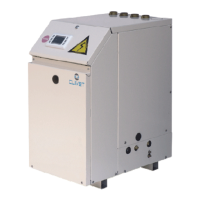pag 43
TROUBLESHOOTING
THE OPERATIONS MUST BE CARRIED OUT BY TECHNICAL QUALIFIED PERSONNEL HAVING THE REQUISITES
UNDER LAW REQUISITES AND IN CONFORMITY WITH THE SAFETY REGULATIONS IN FORCE.
THE INTERVENTIONS WITHIN THE WARRANTY PERIOD WILL BE CARRIED OUT BY AUTHORIZED SERVICE
CENTERS.
BEFORE RESETTING AN ALARM, IDENTIFY AND ELIMINATE ITS CAUSE.
REPEATED RESETS MAY CAUSE SERIOUS DAMAGES.
In certain machine configurations, some safeties may be placed in series and lead back to a single input on the electronic
module.
Therefore, check on the electrical diagram whether the device to which the alarm corresponds has other devices or
safeties connected in series.
Below is a list of the possible causes of alarms.
HIGH PRESSURE cooling
1. high water temperature (see operating limits)
2. insufficient water flow to the exchanger (high
thermal difference between input and output)
3. not CONSTANT flow (for example, if the pumps
are turned off, certain areas of the plant are
excluded or included, other uses are isolated, etc )
4. Dirt water filter / valves open /air bubbles in the
plant
5. dirty exchanger
6. Manostat/transducer: loose electric
contacts/terminals, wiring cables interrupted
7. condensation gas in the cooling circuit
8. Too much refrigerant
9. Check the trigger point for the manostat and
transducer
10. Check the manostat or transducer pressure
control point (deposits of oil, dirt, pin blocked
mechanically)
LOW PRESSURE cooling
1. low water temperature (see operating limits)
2. insufficient water flow to the exchanger (high
thermal difference between input and output)
3. not CONSTANT flow (for example, if the pumps
are turned off, certain areas of the plant are
excluded or included, other uses are isolated, etc)
4. Dirt water filter / valves open /air bubbles in the
plant
5. dirty exchanger
6. Manostat/transducer: loose electric
contacts/terminals, wiring cables interrupted
7. refrigerant circuit empty, visible leaks of
refrigerant/oil, insufficient charge
8. dryer filter clogged
9. thermostatic device not operating correctly
10. Check the trigger point for the manostat and
transducer
11. Check the manostat or transducer pressure
control point (deposits of oil, dirt, pin blocked
mechanically)
FAULTY PROBE
1. Identify the part on the wiring diagram.
2. Loose electric contacts/terminals, leads broken
3. Check the correct probe ohmic level (using a
tester)
4. Change the probe.
5. Check the electronic module configuration (only an
authorised service centre can do this)
6. Change the electronic module
FAULTY PRESSURE TRANSDUCER
1. Identify the part on the wiring diagram
2. Loose electric contacts/terminals, leads broken
3. Check the pressure test points are in working
order
4. Change the part
5. Check the electronic module configuration (only an
authorised service centre can do this)
6. Change the electronic module
COMPRESSOR PROTECTION
1. Identify the part on the wiring diagram
2. Loose electric contacts/terminals, leads broken
3. electrical windings interrupted
4. Vacuum power voltage below the limits
5. power contactors / contacts defective
6. start-up power voltage lower than the limits
7. electrical absorption high / unbalanced
8. High compressor discharge temperature >
thermostatic device needs calibrating, insufficient
refrigerant charge
PUMP PROTECTION
1. Identify the part on the wiring diagram
2. pump jammed (probable for circulator pump after
lengthy seasonal shutdowns)
3. Loose electric contacts/terminals, leads broken
4. electrical windings of fan interrupted
5. power supply voltage below limits
6. electrical absorption high / unbalanced

